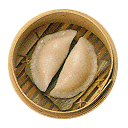|
|
Special/Dim Sum
More about Dim Sum
A unique Chinese food is dim sum. Actually dim sum is more than just a category of dishes; it's
an eating habit.

Introduction
In the Canton provinces, many people gather at tea houses
during the morning and early afternoon to socialize or conduct business over small meals. In China this is most popularly called going to "yum cha" -- going to tea -- because the drinking of tea is so strongly associated with the snack foods served. In the United States, however, we are most familiar with the term dim sum to describe these small meals.
What Is Served
Most dim sum foods are savory pastries -- steamed or fried
dumplings, filled buns, noodles. There are also sweet pastries,
vegetables, meats. The portions are bite-sized, and they are
served in small quantities, usually three or four to a plate, so
that the diners can enjoy a variety of foods, whether they eat
very little or indulge in a huge feast. Variety is one of the keys
to dim sum. Some restaurants offer over 100 different items on a busy day.
How Dim Sum Is Served
The presentation of the dim sum meal has no equivalent in the
West. Servers push carts, loaded with a variety of foods, through
the dining room, past the customers, who keep an eye
out for appealing dishes. Once a desired item is in sight, the
diner flags down the cart and points out what she wants. The
dining room bustles with the activity of carts wending among
tables, calls for attention, and the clatter of plates. The idea is to
choose things continually throughout the meal, rather than to
gather all the food at once before eating. Sweet items are
interspersed with the savories; Chinese custom does not include
saving sweets for the end of the meal, although they are reserved
for special occasions, such as the pauses between
courses in a banquet or indulgences like dim sum.
Tea
Just as the arrival of food is ongoing, the supply of tea is
endless. When a teapot is empty, the customer need only leave
the lid up, and it will be whisked away and refilled. One story
told to explain this custom involves a poor student who hid a
bird in his teapot. When the waiter came to refill the pot and
lifted the lid, the bird flew away. According to his plan, the
student made a loud fuss. It was a very valuable bird, he said,
and the restaurant owed him recompense. After this, the
restaurant-and all others--decided to wait for customers to lift
the lid of an empty teapot if a refill was needed.
The Bill
When the diners have eaten their fill, the bill is calculated by
counting up the number of plates on the table.
|
|